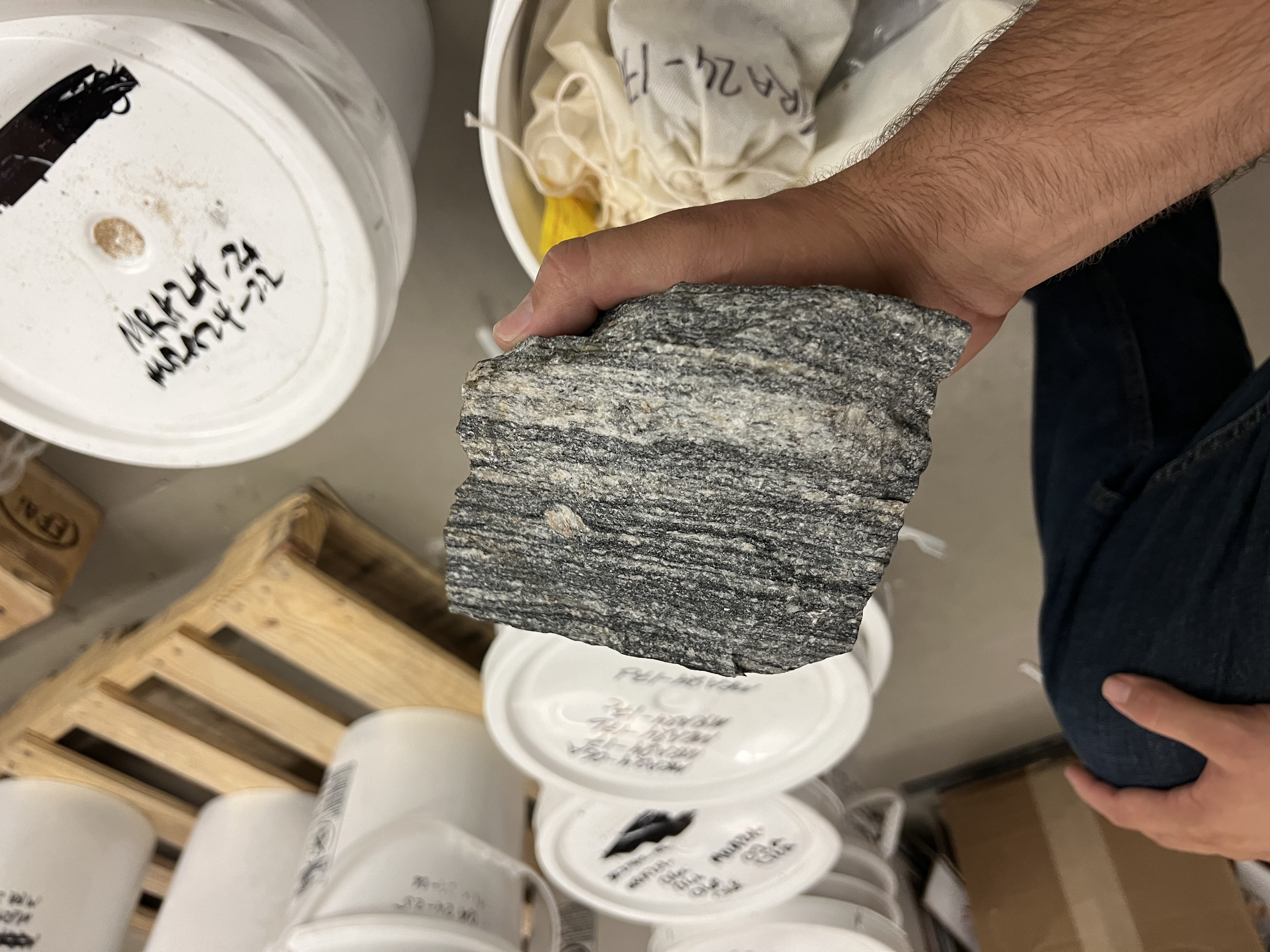NATIONAL MUSEUM OF NATURAL HISTORY
Searching for Earth’s Oldest Rocks: Follow a Smithsonian Expedition to the Remote Northwest Territories
High in the Canadian wilderness, Smithsonian scientists search for ancient minerals that could explain the origins of the continents, oceans and life on Earth
:focal(2000x1505:2001x1506)/https://tf-cmsv2-smithsonianmag-media.s3.amazonaws.com/filer_public/66/c5/66c50dc0-be99-4fbe-8cbf-79abbb34e0e5/p7252757.jpg)
Beneath the perpetually bright subarctic summer sun, a team of researchers ventured deeper into the vast, untamed wilderness of Canada’s Northwest Territories. As their boots sank into the marshy tundra and mosquitoes buzzed in their ears, the scientists were driven by a singular mission: to collect the oldest rocks on Earth.
Earth was formed over 4.5 billion years ago, but little physical material has survived from that early period. Today, the planet’s ancient secrets are locked away in rare geological relics, scattered across the globe like elusive time capsules. While only a handful of these primordial minerals exist in scientific collections, they hold the key to understanding the early Earth—its continents, oceans and the origins of life.
/https://tf-cmsv2-smithsonianmag-media.s3.amazonaws.com/filer_public/3d/53/3d539b9e-3209-4b04-a3e2-a4b4942488e8/pxl_20240720_215954201mp.jpg)
“The earliest rocks on our planet tell a story of the nascent stages of Earth before modern-style plate tectonics and long before life,” said Michael Ackerson, a research geologist at the National Museum of Natural History. “Analyzing these rocks is the only direct way for us to observe the Earth 4 billion years ago, but it is almost impossible to find them.”
This summer, Ackerson and NMNH postdoctoral research fellow Wriju Chowdhury led an expedition to a remote rock formation known as the Acasta Gneiss in Canada’s Northwest Territories. Their goal was to collect more early Earth material for their own research and the Smithsonian’s National Rock and Ore Collection, where the samples would be available to scientists from around the world.
While many still picture scientific expeditions as rugged adventures, modern fieldwork is a blend of cutting-edge technology and the enduring challenges of remote exploration. As Ackerson and Chowdhury documented the many trials and triumphs they experienced while traversing the deep wilderness, they offered a rare glimpse into daily life on the frontier of scientific discovery.
Planning an expedition into the middle of the Canadian tundra begins months in advance. The research team would need food, water, field supplies, a detailed emergency protocol and float planes to transport their heavy rock samples back from this remote, island-speckled landscape. After meticulously preparing for every possible scenario, the team set out for the field in early July.
/https://tf-cmsv2-smithsonianmag-media.s3.amazonaws.com/filer_public/98/ed/98ed3d95-210b-4a12-a3e8-b0b0607a757e/pxl_20240724_152141331mp.jpg)
The small city of Yellowknife, Canada (population of less than 25,000 people), would be the team’s last taste of civilization for weeks. They would spend the next 17 days camping on a remote island, more than 100 kilometers (62 miles) from the nearest town. Between research geologist Jesse Reimink, PhD candidate Ben Neil, Northwest Territories Geologic Survey researcher Rebecca Canam, and their tough-as-nails float plane pilot Dave, the expedition team had decades of field experience to draw from. But every trip to the wilderness brings its own set of unique challenges, and even the most seasoned experts need to remain cautious of the unknown.
The biggest obstacle the research team would face became clear on the first day of the expedition. “Summer days near the Arctic circle are characterized by 24 hours of eternal sunlight, and it never gets cool or dark,” Chowdhury said. “We realized very quickly that our biological clocks were completely thrown off, and we would often wake up at 4am to temperatures of over 100 degrees in our tents.”
/https://tf-cmsv2-smithsonianmag-media.s3.amazonaws.com/filer_public/3a/5b/3a5b1953-af24-477f-ab82-e07c0aff558d/pxl_20240727_054213418mp.jpg)
/https://tf-cmsv2-smithsonianmag-media.s3.amazonaws.com/filer_public/35/d9/35d98f54-f629-4ad0-b0f7-3ff820cd1bac/pxl_20240717_142825650mp.jpg)
The Acasta Gneiss is a vast geologic formation that covers over 5,000 square miles. This makes locating a tiny outcrop of ancient minerals daunting. Although the Acasta Gneiss is known to contain the oldest rocks on Earth, finding the 4-billion-year-old samples is like searching for a needle in a haystack.
/https://tf-cmsv2-smithsonianmag-media.s3.amazonaws.com/filer_public/26/ea/26ea35c4-4be9-4b9b-8d1b-7185216460f0/pxl_20240715_173349314mp.jpg)
Every rock in the region is made up of multiple layers, each with a completely different geologic age. If you pick a spot on one of these rocks, the layer directly above it might be 500 million years younger. Luckily, the Earth’s oldest rocks have a unique characteristic that sets them apart from the rest of the Canadian landscape: they are all magnetic.
“Our time out in the field was basically a magnetic treasure hunt,” Ackerson said. Early Earth’s crust was saturated with iron-rich minerals like pyrite, iron-rich garnets, and magnetite — which gives the rocks a magnetic quality. In the field, the research team would search for tiny red flecks of garnet visible in the rocky landscape. Once they found a location with this distinctive red signature, they would test the rocks with a pen magnet. If it stuck, they could be fairly certain they had found the oldest rocks on Earth.
When Ackerson and Chowdhury pinpointed an area that they wanted to sample, they would spend hours fanning out over the landscape, bushwhacking through the brush to follow the geologic lines that were etched into the crust. “It was like the strangest forensic study ever," Chowdhury said. “We were scouring every inch of the land for clues like sheriffs searching for a missing person, except we did it holding magnets in our hands.”
/https://tf-cmsv2-smithsonianmag-media.s3.amazonaws.com/filer_public/1f/12/1f124b82-4ea0-4d40-a3ec-6bc835e7d1e2/pxl_20240713_202405446mp.jpg)
After hours of hiking in the blistering sun, the team would wait for their float plane to pick them up and take their samples back to camp. In the tundra, two miles of walking can feel like 20, and every day was a physical challenge. “Imagine hiking through honey,” Ackerson said. “Your feet are constantly caught in the marshy sand, and you are just bouncing and sinking into all of the dried moss and lichen that has settled there.”
Although the days were long and tiring, Ackerson and Chowdhury have genuine fondness for their time in the remote wilderness. Their evenings were spent swimming and fishing in the cool lakes, picking wild blueberries, and discussing the origins of Earth with colleagues from all over the world.
/https://tf-cmsv2-smithsonianmag-media.s3.amazonaws.com/filer_public/d1/02/d1021850-18b0-486e-8005-13cc365c23cd/riggi8yk.jpeg)
“During the entire expedition, we were pausing to appreciate the absolute privilege that it was to be out there,” Chowdhury said. “We had the opportunity to stand on the oldest rocks on the planet, and that was only possible because dozens of people at the Smithsonian helped us make it happen.”
The team returned with more than 1000 pounds of rocks from the Acasta Gneiss. Now, back at the museum, the real scientific discoveries can begin. In the coming months, Ackerson and Chowdhury will process all of the samples into the Smithsonian’s National Rock and Ore Collection, where they will be available for generations of future scientists to study.
“Researchers from all over the world have thought about these rocks and have amazing ideas that they want to test on these samples,” Ackerson said. “Putting them into the national collection will open the samples up for a global community of scientists, whose observations could completely change how we view the earliest Earth.”

Ackerson and Chowdhury will also conduct their own analyses of the materials, looking for chemical signatures in the rocks that could contain information about the environments in which they were created. 4.5 billion years ago, Earth was a planet covered by oceans of magma. These samples could reveal the geochemical steps that transformed the planet into the lush biosphere that we live on today. The research will support the museum’s Our Unique Planet initiative, which seeks to further our understanding of the origins of the continents, the oceans and life on Earth.
“These rocks are so rare, very few people have ever had access to them,” Ackerson said. “But now, the entire scientific community can work together to answer some of the biggest questions about our planet.”
Related Stories
Meet the Scientist Venturing to Remote Canada in Search of the Earth’s Oldest Rocks
New Study on Zircons Finds Plate Tectonics Began 3.6 Billion Years Ago
Uncovering Earth’s Secrets One X-ray at a Time
NMNH in Review: How an Asteroid Sample Traveled From Outer Space to the Museum’s Mineral Hall

